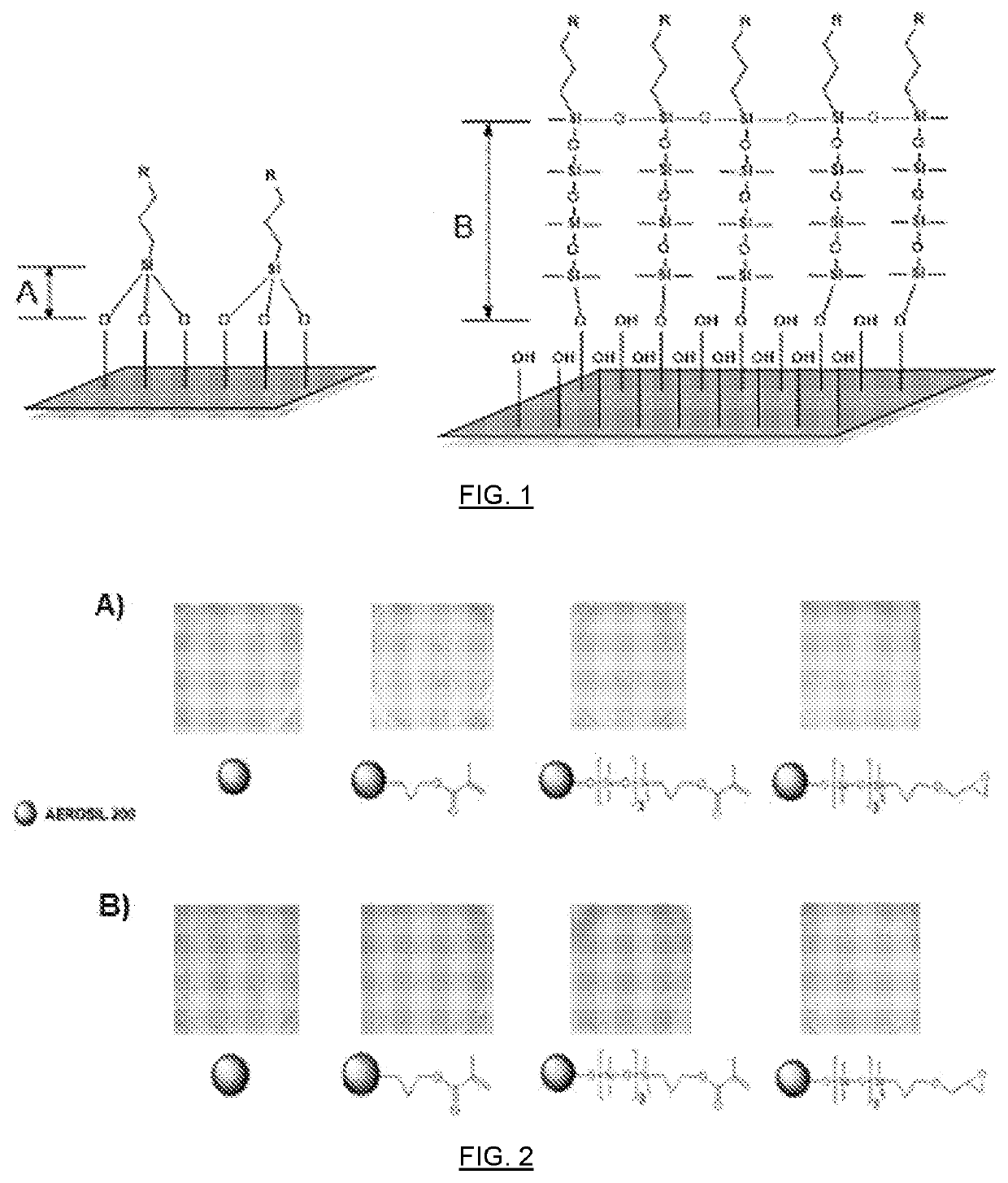Organofunctional siloxanes, process for preparing same and their use for the treatment of fillings and surfaces
a technology of organofunctional siloxanes and copolymers, which is applied in the field of organofunctional siloxanes, dipodal siloxanes and siloxane block copolymers, can solve the problems of increasing wear resistance of catalysts, and achieve the effects of reducing voc emissions, slowing down reactivity, and reducing voc conten
- Summary
- Abstract
- Description
- Claims
- Application Information
AI Technical Summary
Benefits of technology
Problems solved by technology
Method used
Image
Examples
example 1
chloro-1,1,3,3,5,5-hexamethyl-7-octyltetrasiloxane
[0060]
[0061]A 250-ml four neck glass reaction flask equipped with overhead stirring, reflux condenser, pot thermometer and addition funnel, is charged with 5 g of toluene and 0.095 g of 2 wt % Karsted's catalyst solution (20 ppm of Pt). The solution is heated to 90° C. and via an addition funnel a solution of 19.6 g (0.17 mol) of 1-octene and 75.13 g (0.17 mol) of 1,7,7-trichloro-1,1,3,3,5,5-hexamethyltetrasiloxane is added at such a rate to maintain the reaction temperature between 90 to 95° C. Once the addition of the solution is finished, the reactor contents are maintained at 90° C. for 30 minutes after which a sample is obtained for GC analysis to confirm that all the raw materials have been consumed. The product is then flash distilled to produce 1,7,7-trichloro-1,1,3,3,5,5-hexamethyl-7-octyltetrasiloxane with a purity of 97% by GC analysis resulting in a 90% isolated yield.
example 2
1,1,3,3,5,5,7,7-octamethyl-7-octyltetrasiloxane
[0062]
[0063]A 5-liter four neck glass reaction flask equipped with overhead stirring, reflux condenser, pot thermometer and addition funnel is charged with 400 g of toluene. The toluene is heated to 90° C. and 1.60 g of 2 wt % Karsted's catalyst solution (20 ppm of Pt) is added to the reaction flask. A solution of 1173 g (3.7 mol) of 1-chloro-1,1,3,3,5,5,7,7-octamethyltetrasiloxane and 436 g (3.9 mol) of 1-octene is added via an addition funnel at rate to maintain the reaction temperature between 90 to 100° C. Once the addition is finished, the reactor contents are kept at 100° C. for 30 minutes after which a sample is obtained for GC analysis to confirm that all the raw materials have been consumed. The reaction solution is flash distilled to obtain 1492 g of 1-chloro-1,1,3,3,5,5,7,7-octamethyl-7-octyltetrasiloxane with a purity higher than 96%.
example 3
1,1,3,3,5,5,7,7-octamethyl-7-dodecyltetrasiloxane
[0064]
[0065]A 250-ml four neck glass reaction flask equipped with overhead stirring, reflux condenser, pot thermometer and addition funnel, is charged with 5 g of toluene and 0.11 g of 2 wt % Karsted's catalyst solution (20 ppm of Pt). The solution is heated to 90° C. and via an addition funnel a solution of 37.25 g (0.22 mol) of 1-dodecene and 71.81 g (0.22 mol) of 1-chloro-1,1,3,3,5,5,7,7-octamethyltetrasiloxane is added at such a rate to maintain the reaction temperature between 90 to 95° C. Once the addition of the solution is finished, the reactor contents are maintained at 90° C. for 30 minutes after which a sample is obtained for GC analysis to confirm that the raw materials have been fully consumed; yielding 86% of the desired product (1-chloro-1,1,3,3,5,5,7,7-octamethyl-7-dodecyltetrasiloxane).
PUM
| Property | Measurement | Unit |
|---|---|---|
| Specific surface area | aaaaa | aaaaa |
| Volume | aaaaa | aaaaa |
| Volume | aaaaa | aaaaa |
Abstract
Description
Claims
Application Information
 Login to View More
Login to View More - R&D
- Intellectual Property
- Life Sciences
- Materials
- Tech Scout
- Unparalleled Data Quality
- Higher Quality Content
- 60% Fewer Hallucinations
Browse by: Latest US Patents, China's latest patents, Technical Efficacy Thesaurus, Application Domain, Technology Topic, Popular Technical Reports.
© 2025 PatSnap. All rights reserved.Legal|Privacy policy|Modern Slavery Act Transparency Statement|Sitemap|About US| Contact US: help@patsnap.com



